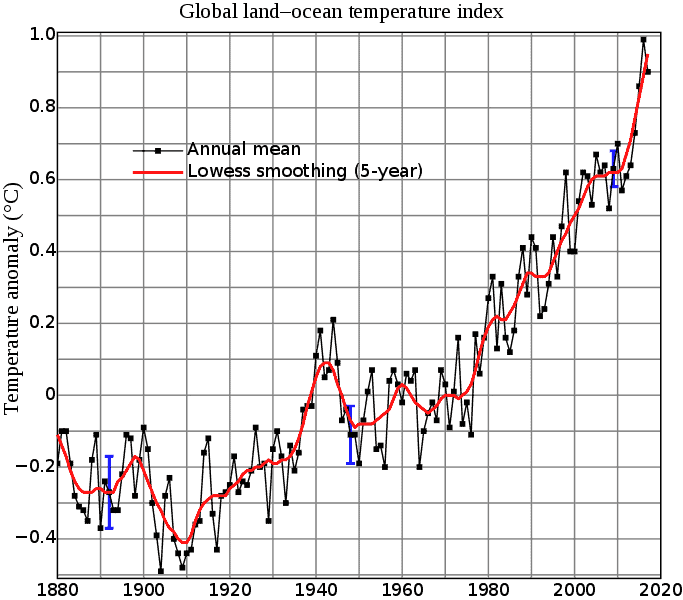Between roughly 1850 and the present day, the trend in global mean surface temperature (GMST) has, generally speaking, been positive, meaning the GMST has been rising.
Interestingly, though, from 1940 to 1980 GMST stabilized. (See temperature plot at bottom).
Incidentally, as reported by NASA’s Earth Observatory the GMST has increased a total of 0.7 degrees Celsius in the past 100 years alone.
Meanwhile, on June 15, 1991, Mount Pinatubo on Luzon, a main island in the Philippines erupted, hurtling roughly 17 million tons of sulfur dioxide (SO2) into the stratosphere. One event leading to another, what transpired next was, in fact, the formation of clouds of sulfate aerosols. As it turned out, the cover from the clouds was indeed widespread. And, because of such, large swaths of the planet’s surface in 1992-’93 underwent solar radiation loss and that, in turn, translated to a GMST loss of perhaps 0.4 degrees Celsius. Meanwhile, the Earth’s surface over the Northern Hemisphere had cooled by upwards of 0.5 to 0.6 degrees Celsius.1
If in the case of the early ’90s reference the global-mean-surface-temperature cool-down is due to a multi-megaton increase in SO2 in the stratosphere with resultant sulfate aerosol cloud formation (in this case such being volcano-eruption driven), then logic would have it that what was responsible for the GMST normalization occurring throughout the 40-year stretch in question is related; in other words, precipitous, elevated stratospheric sulfur dioxide concentration and subsequent and consequent sulfate aerosol cloud formation. If so, then what could very well explain the resumption in the rise in post-1980 GMST is a substantial reduction in not only stratospheric sulfur dioxide level but, as well, the presumed add-on sulfate-aerosol clouding. It’s what makes sense.
Your thoughts?
As for the SO2, it is important to note that non-naturally-occurring sulfur dioxide, among a number of released pollutant emissions, can come as a result of the burning of fossil fuels. It’s emitted from gasoline- and diesel-powered combustion from on- and off-road vehicles, trains, various internal-combustion-engine-powered lawn and garden equipment, generators, oil- and coal-fired power plants and more.
For even more perspective, consult: The Atmospheric Impact of the 1991 Mount Pinatubo Eruption, United States Geological Survey, https://pubs.usgs.gov/pinatubo/self; “Global Temperature,” Global Climate Change: Vital Signs of the Planet, NASA https://climate.nasa.gov/vital-signs/global-temperature; “Climate change: How do we know?” Global Climate Change: Vital Signs of the Planet, NASA https://climate.nasa.gov/evidence; and “Two degrees can do all that?” a Jul. 21, 2019 blog on A New Shade of Green by Sherry Listgarten (and comments, too). https://www.paloaltoonline.com/blogs/p/2019/07/21/two-degrees-can-do-all-that
Notes
- Stephen Self et al. The Atmospheric Impact of the 1991 Mount Pinatubo Eruption, “Abstract,” United States Geological Survey, undated. https://pubs.usgs.gov/pinatubo/self
Images: U.S. Geological Survey Photograph taken by Richard P. Hoblitt (upper); NASA Goddard Institute for Space Studies (lower)
Published by Alan Kandel

